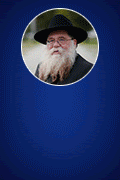Trying to convey the impact of the late Rabbi Menachem Mendel Schneerson in two dozen or so 20-minute long academic presentations, which were delivered at the conference held Sunday through Tuesday at NYU's student center on Washington Square, was a little like reaching for the infinite with arms only inches long.
This was the first-ever academic conference devoted to the life and work of Rabbi Schneerson, who led the Chabad movement from 1951 until his death in 1994, and helped it grow into the largest Jewish outreach network in the world. Held under NYU's auspices, the meeting was funded by Chabad supporters George and Pamela Rohr, and Craig and Deborah Cogut, and attended by up to 150 people at a time, ranging from Lubavitch chasidim to Reform rabbinical students.
The Rebbe Meets The Academy
“Reaching for the Infinite: The Lubavitcher Rebbe – Life, Teachings and Impact” was more apt a title for the conference which took place this week at New York University than even its organizers may have realized.
Trying to convey the impact of the late Rabbi Menachem Mendel Schneerson in two dozen or so 20-minute long academic presentations, which were delivered at the conference held Sunday through Tuesday at NYU’s student center on Washington Square, was a little like reaching for the infinite with arms only inches long.
This was the first-ever academic conference devoted to the life and work of Rabbi Schneerson, who led the Chabad movement from 1951 until his death in 1994, and helped it grow into the largest Jewish outreach network in the world. Held under NYU’s auspices, the meeting was funded by Chabad supporters George and Pamela Rohr, and Craig and Deborah Cogut, and attended by up to 150 people at a time, ranging from Lubavitch chasidim to Reform rabbinical students.
The conference’s organizer, Lawrence Schiffman, said in an interview that he hoped “to create an intellectual discourse that didn’t exist before” on the rebbe. Schiffman, a Dead Sea Scrolls expert and chairman of NYU’s department of Hebrew and Judaic Studies, explained that “the rebbe is a major phenomenon in modern Jewish life.”
There may be no other 20th century rabbi as influential, recognizable ñ or controversial – beyond his own religious community as Rabbi Schneerson, whose reputation has been somewhat diminished by the controversy surrounding the insistence by many of his followers that he is the messiah, a dispute that has divided his chasidim.
Speakers’ approaches and topics varied widely. Some focused on esoteric aspects of the rebbe’s particular take on kabalistic ideas, some on his Torah scholarship and others on his involvement with politics, both domestic and Israeli, or with art, music and psychology.
Several speakers were Lubavitch chasidim in academia, and others, including Schiffman, can be described as friends of the non-messianist leadership faction of Lubavitch.
While Chabad’s most reviled critic, Brooklyn College professor of history David Berger, was purposely left off of the panel, another long-time critic of messianist aspects of the movement, Allan Nadler, a professor of Jewish studies at Drew University, was invited to participate. His presentation, “Mitnagdic Opposition to the Rebbe,” wandered into opposition by other chasidic rebbes as well, and delved into how it played out in Israeli party politics.
Rabbi Norman Lamm, retired president of Yeshiva University, who spoke on “The Rebbe, Mysticism and Philosophy” on Tuesday, was the first to address Lubavitch messianism head-on. In speaking for the first time in public about the rebbe, there was much he lauded, asserting that “his genius lay in his exquisite combination of high intellect and his ongoing concern about each and every individual Jew, not only his own group.”
But he also sharply criticized the messianic thrust that the public face of the movement seems to be increasingly taking.
“I do not believe that the rebbe thought himself to be moshiach. But I do think he considered himself a possible candidate,” said Rabbi Lamm. He decried the movement’s “over-emphasis on messianism” and castigated those who now say that the rebbe is the messiah but simply concealed from view.
“To continue this myth of his being moshiach is utter ridiculousness,” he said. It is easy for the messianically-oriented “to distort” the rebbe’s teachings and say “that the rebbe is part of the God-head. That is completely heretical and quite dangerous,” he asserted. “I wonder if this distortion could and should have been aoided by responsible leadership of a movement that has not lost its vitality.”
Naftali Loewenthal, in the conference’s final session, ardently defended his movement from the messianists in a paper titled “Chabad, the Rebbe and the Messiah in the 21st Century.”
He protested their reductionist, myopic focus and called their opponents, who run many of the movement’s institutions, “the spiritual elite” of Lubavitch.
“There are attempts by moshiachists to define the rebbe as just one theme,” said Loewenthal. “But even his messianic thrust was not one-dimensional.”
He said “every Jew has a role to play in the quest to make the world a dwelling place for the divine.”
Several speakers mentioned the difficulty in fully grasping the rebbe’s depth and inner personality. With the rebbe, “you pull the veil aside and there’s another veil,” said Elliot Wolfson, a professor of Hebrew and Judaic studies at NYU. “Even when you open up one avenue to understanding him, there’s another one to open. There is always another veil.”
William Helmreich, a professor of sociology and Judaic studies at the City University of New York, may have best summed up the rebbe’s complexities when he used his presentation on “The Rebbe’s Relation to Jewish Communal Organizations and Religious Movements” as an opportunity to portray him as a man of paradox.
For example, the rebbe seemed “flexible yet his official stance was opposed to contamination by the outside world. He had friends in every denomination but opposed cooperation,” he said.
Helmreich also adroitly plucked from the range of positions, campaigns and views the essence of what made the rebbe successful. In his view, it was the fact that the rebbe communicated that “each mitzvah has value unto itself.”
In other words, performing a mitzvah was not simply a first step, but something of infinite inherent value whose worth could also echo in higher worlds.
“The rebbe sought mitzvahs, not membership, from the Jews he met,” said Helmreich. “It is this focus on mitzvahs that is Chabad’s greatest contribution.”
Alan Brill, a rabbinic expert on Jewish mysticism and associate professor of Judaic studies at Yeshiva University, spoke about “The Rebbe as a Modern Thinker.”
The rebbe believed “that Judaism changes, that revelation is continuous and progressive, therefore our age deserves new approaches in order reach everyone. He asserts that we are not Godless moderns based on the Enlightenment, but that now God is closer than he ever was before.” The rebbe’s goal, he said, “was to bring 20th century Judaism away from materialism. It was rare in 20th century religion to describe America as full of meaninglessness, neurosis and laziness,” as the rebbe did, Brill said.
“In America at a time of assimilation,” said Brill, the rebbe saw that “more important than the four sons at the seder was to reach the fifth son, who was not there.”
Jeff Shandler, an associate professor of Jewish Studies at Rutgers University and a maven of American Jewish culture, spoke about the rebbe and media.
Unlike all other chasidic rebbes and fervently Orthodox rabbinic leaders who have recently banned use of the Internet, Rabbi Schneerson saw “technology as not inherently corrupting, but containing the potential to be integrated into Judaism’s spiritual mission.”
And indeed it was video of the rebbe that provided one of the conference’s most compelling moments, during a presentation on the rebbe’s relationship to music by Mark Kligman, a professor of Jewish musicology at the Reform movement’s Hebrew Union College-Jewish Institute of Religion.
When he played old videotape of the rebbe, from 1973 and 1980, singing a Lubavitch niggun (wordless melody), everyone in the conference room was riveted. Because it took that grainy black-and-white footage of the rebbe singing, and hundreds of his followers around him responding as one, to finally reveal what all the academic presentations simply could not: the power of the rebbe’s charisma











